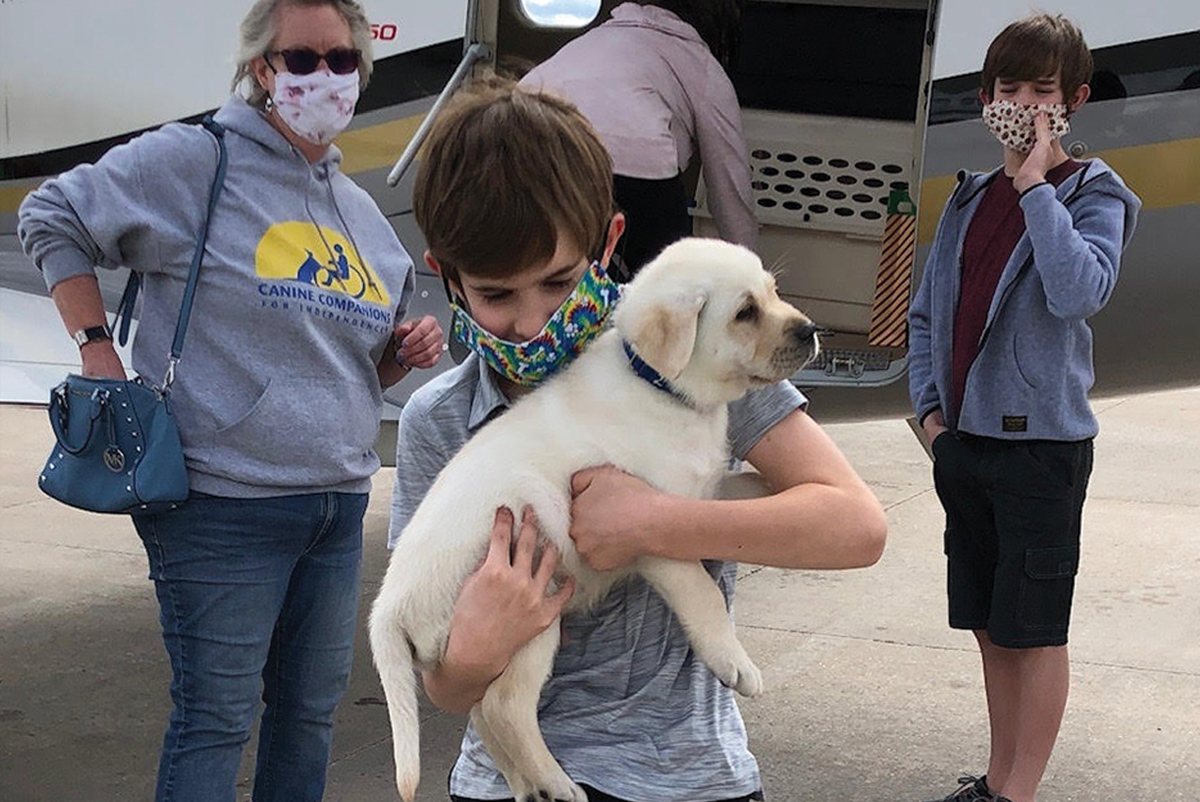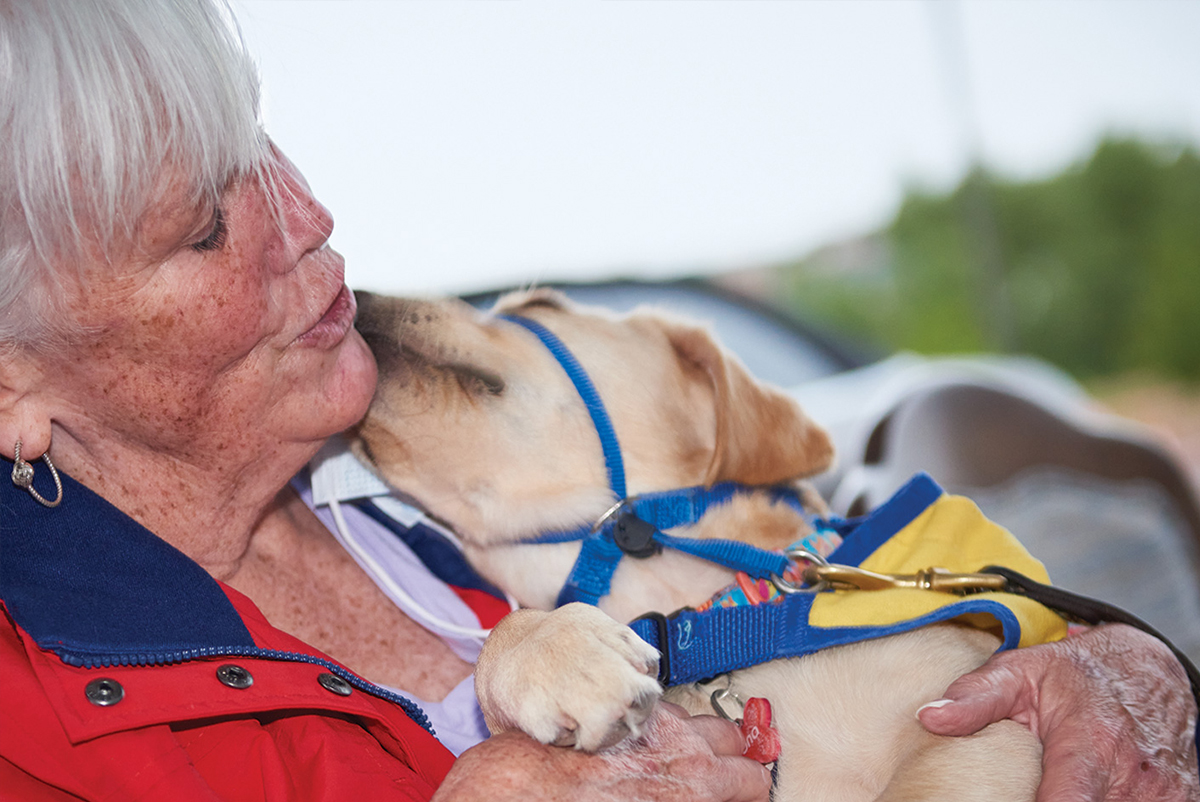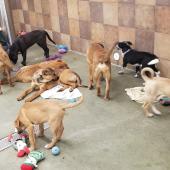Canine Companions
On an April morning in 2020, at the lowest point of the pandemic, Laurel Prud’homme drove to Centennial Airport in southeast Denver to meet a private jet carrying eight VIPs. Commercial airline traffic was severely restricted; a private pilot had volunteered for the hazardous assignment. Each of the passengers had been carefully screened for the right combination of physical gifts and temperament to accomplish a critical mission. They had come to the Rocky Mountains for months of training before they would be deemed ready to face a lifetime of dedicated service.

Prud’homme knew little about the individual she had come to meet other than the fact that he was known only as “Edge.” She and a small knot of volunteers waited apprehensively for the plane to come to a halt. As the jet door unfolded, eight tentative, curious, eight-week-old puppies were brought out, soon to begin 18–20 months of intensive training to become skilled companions, service dogs, hearing dogs, PTSD dogs, and facility dogs.
Edge is a yellow Labrador retriever from Canine Companions (CC), bred in their Santa Rosa, CA, facility. CC has been training service dogs for four decades, and it provides them to adults, children, and veterans seeking greater independence at no charge—despite the fact that each dog will receive $50,000–$60,000 worth of training. Prud’homme is one of thousands of volunteer puppy trainers nationwide who take in eight-week-old pups to prepare them for the more specialized training required before the dog is ready to aid a disabled owner.
Because of their size and temperament, Prud’homme says Labs, golden retrievers, and Lab/golden mixes are well-suited for the mission: “If you’re looking for a service animal that can help pull a manual wheelchair, you need a dog of a certain size and stamina.” Their size allows them to press plates to open doors and reach light switches. The breeds also have a good disposition for the work.

Prud’homme outlines what Edge’s basic training will look like: “First we focus on fundamental things like housebreaking and learning their name; over the course of our time, we teach them about 30 commands. Our job is basic obedience, learning those commands, and learning how to be good citizens when they’re out in public.” They have to be taught how to behave appropriately: not to run up to strangers wagging their tail in overexcitement, how to ignore other dogs instead of chasing them, etc. Early on, babies and small children were Edge’s biggest distraction; any time he encountered an infant in a stroller, he thought he had met his best friend.
Prud’homme has heard the criticism that service dogs never get to be dogs. “That is absolutely a myth,” she says. “These dogs get a ton of time to play with toys, play with other dogs, go on hikes… Edge has been swimming. They get to do all the things dogs do; they also have to learn that, when they’re working, they need to be focused.”
Not all dogs are cut out to be service dogs. Some will learn the commands but appear disinterested. Some have health issues, such as dysplasia. Some are afraid of elevators or children. The puppy raiser gets first right-of-refusal to adopt such dogs; if not, there is a long waiting list to adopt what CC calls these “career change” dogs. Some dogs are shifted to another line of work that suits them, such as bomb sniffing. Overall, though, more than 50% of CC’s dogs complete the training and go on to aid someone with one of more than 65 disabilities.
Being a puppy raiser benefits Prud’homme’s health, too. “There are mental benefits to having pets that science has proved, such as lowering your stress level,” she says. “It brings an emotional boost just having that animal’s presence in the workplace. For me, it’s the perfect mix of being able to have a dog, being able to give back to the community, and being able to do something that’s meaningful. Yeah, that’s kind of the sweet spot for me.”
The hardest part of the training has to be when Prud’homme will take Edge to the airport for a flight to Oceanside, CA, for further training. “You intentionally choose to do this with the goal that this dog will go to somebody else to make their world easier. And then the day comes when you turn them over; other puppy raisers are turning in their dogs, and the funny part is that the dogs are so excited because there are other dogs there, tails wagging. You stand there and think, ‘They didn’t even look back,’ but, you know, it’s what you signed up for.”
Months after turning in her first puppy, Prud’homme had the chance to visit him in his new home. “It was very heartwarming to see how bonded the puppy I raised was with his person. I knew he was doing great work for her and that he was really loved and cared for. It really gave me a sense of peace.”



